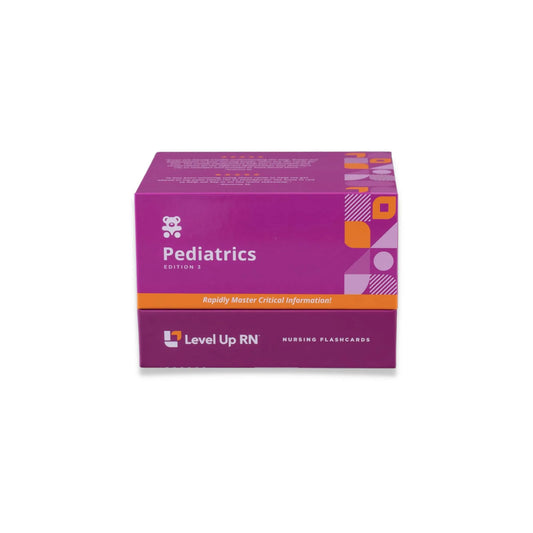When you see this Cool Chicken, that indicates one of Cathy's silly mnemonics to help you remember. The Cool Chicken hints in these articles are just a taste of what's available across our Level Up RN Flashcards for nursing students!
Pediatric Nursing - Flashcards
In this article, we discuss the pediatric vaccination schedule and some key facts to know about immunizations.
The Pediatric Nursing series follows along with our Pediatric Nursing Flashcards, which are intended to help nurses and nursing students learn and retain information about caring for pediatric patients. The flashcards are a clear, complete study tool and a helpful reference for practicing RNs, PNs, and other medical professionals.
Pediatric vaccine schedule
Note: The charts on our Pediatric Nursing Flashcards are a handy way to get to know the pediatric vaccination schedule for young and older children.
CDC recommended vaccinations for children from birth to 6-years old
Hep B
Hepatitis B is the only vaccination we give at birth. It is given again at two months of age, and then again at six months of age. To complete the hepatitis B series, a child has to have all three vaccinations.
RV
Rotavirus is a highly contagious virus that causes diarrhea and other intestinal symptoms. The RV vaccine is administered at around 2 months of age.
DTaP
DTaP, the diphtheria (highly contagious bacterial disease), pertussis, and tetanus (a serious disease of the nervous system caused by a toxin-producing bacterium) vaccine, is administered at around 2 months of age.
Hib
The vaccine for Hib, haemophilus influenzae b, is very important to help prevent a certain type of meningitis. Hib is administered at around 2 months of age.
PCV
PCV is the pneumonia conjugate vaccine, a pneumonia vaccine for younger children. It is administered at around 2 months of age.
IPV
IPV is the polio vaccine. Polio is a disabling and life-threatening disease caused by the poliovirus. IPV is administered at around 2 months of age.
MMR
MMR is the abbreviation for the combined vaccine for measles (an infectious viral disease causing fever and a red rash on the skin), mumps (a contagious disease caused by a virus whose symptoms include swollen salivary glands and a fever), and rubella. The MMR vaccine is administered as a live vaccine, starting at 12 months of age. It is not administered earlier, because live virus vaccines are contraindicated for anyone less than one year of age.
Varicella
Varicella is a herpesvirus that causes chickenpox and shingles (a viral infection that causes a painful rash). Like MMR, it is a live vaccine, administered starting at 12 months of age and contraindicated for anyone less than one-year old.
Hep A
Hep A is used to prevent hepatitis A, a type of liver disease. The Hep A vaccine is administered starting at 12 months.
Influenza
The seasonal influenza vaccines should be administered annually, starting at age 6 months or older, at the start of that year's flu season.
CDC recommended vaccinations for children 7- to 18-years old
For older kids, some vaccines continue, while a new slate of vaccines begins.
Meningococcal (MenACWY)
Starting around ages 11–12, a meningococcal vaccine is administered, which offers protection against four types (serogroups A, C, W, and Y) of Neisseria meningitidis bacteria.
Meningococcal (MenB)
As kids get older, they get a different version of the meningitis vaccine. Serogroup B meningococcal (MenB) vaccine is administered when children turn 16 and protects against the single type (serogroup B) of Neisseria meningitidis bacteria. This vaccine is administered to this age group because older kids’ behaviors include more intimate interactions: they may share drinks with each other, some may have begun kissing. This would put them at risk for getting this type of meningitis. The MenB vaccine is administered in 2 doses.
HPV 2
HPV is the human papilloma virus, a very common virus. About two-thirds of the population has HPV. The vaccine is relatively new and is important because HPV can lead to cancer.
The HPV vaccine is administered over 2 doses to kids in the 11- to 12-year range.
Note that this vaccine can be given to kids as young as 9, all the way up to 26 years of age, but 11 to 12 years is the target. The idea is to give this vaccine prior to a child’s first sexual contact in order to prevent HPV transmission. Once a person has HPV, it is not eradicable.
Tdap
Tdap covers the same condition as the early childhood DTaP (diphtheria, pertussis, and tetanus), but Tdap is a different makeup of that vaccine. It is administered to kids in the 11- to 12-year range.
Influenza
Finally, the seasonal influenza vaccine should continue to be administered every year.
General (immunization) contraindications
Some vaccines have specific contraindications (read more below). But all vaccines may present these general contraindications.
Severe allergic reaction
Severe allergic reactions to vaccines include anaphylaxis following vaccination. Anaphylaxis is a potentially life-threatening allergic reaction.
A patient may have an allergic reaction to a component of a vaccine (eggs, for example, which are part of the process for producing the influenza vaccine).
If a patient experiences a severe allergic reaction following vaccination, that means they cannot get that specific vaccination again.
Live vaccines
Live vaccines are contraindicated for children less than one year of age.
Live vaccines are also contraindicated for immunocompromised or pregnant patients.
Note that children can still get vaccinations even if they have a low-grade fever or minor illnesses like a cough, a cold, or an ear infection. It is no longer best practice to skip a vaccination appointment for this sort of low-grade infection or illness.
Vaccine-specific contraindications
The following vaccines are contraindicated as detailed below.
Hep B, HPV contraindications
Both the Hep B and HPV vaccines are contraindicated for patients with a hypersensitivity to yeast.
DTaP, Tdap contraindications
The DTaP and Tdap vaccines are contraindicated for people with neurologic disorders (e.g., epilepsy), for those who contract an encephalopathy (a term for any diffuse disease of the brain that alters brain function or structure) within 7 days of their previous vaccine dose, or for those who contact GBS (Guillain-Barre Syndrome, an autoimmune disorder that affects the peripheral nervous system and causes the sudden onset of weakness and paralysis) within 6 weeks of their previous dose.
RV contraindications
The rotavirus vaccine is contraindicated for patients with a history of intussusception (a medical emergency involving obstruction of the intestine).
It is also contraindicated for anyone with severe combined immunodeficiency (SCID). The NIH defines SCID as a group of rare disorders caused by mutations in different genes involved in the development and function of infection-fighting immune cells.
IPV contraindications
The polio vaccine is contraindicated for patients with a streptomycin (an antibiotic and the first drug to be successful against tuberculosis; its toxic side effects mean it is only used with other drugs), polymyxin B (an antibiotic), or neomycin (an antibiotic related to streptomycin) allergy.
MMR contraindications
In addition to being contraindicated for children under 12 months of age (because the MMR vaccine is a live virus), it is also contraindicated for patients with immunodeficiency, patients who are pregnant, or anyone with a neomycin allergy.
Varicella contraindications
Varicella, like MMR, is a live vaccine, so it is contraindicated for young children (under 12 months). And, similar the MMR vaccine, the varicella vaccine is contraindicated for patients with immunodeficiency, patients who are pregnant, or anyone with a neomycin or gelatin allergy.
Pain management
When it comes to pain management, encourage pain-relieving measures for the young patient. This may mean simply holding them, swaddling them, or breastfeeding. A pacifier could be indicated as well.
Additionally, a topical anesthetic agent may help to alleviate the inoculation site. Oral sucrose is a safe and effective mild analgesic that may be administered to an infant, too.
Administration
Administer IM (intramuscular) vaccines in the vastus lateralis or deltoid muscle. Use the vastus lateralis (thigh) for infants under 12-months old, as the deltoid has not developed enough to handle vaccinations.
Administer the most painful vaccine last. This is important because if the most painful vaccination is administered first, the child will likely get worked up and possibly fight receiving any subsequent inoculation.
Documentation
It is very important to have the proper documentation following a vaccine administration. Document the basics — the vaccine type and the date of administration.
Also make sure to note the vaccine manufacturer, the lot number, the route (how was the vaccine administered?), the dose, the site (where was the vaccine administered?), the name and title of the person who administered the vaccine, the date on the vaccine information statement (VIS), and the date the VIS was given to the child’s parent or guardian. The VIS is an information sheet produced by the Centers for Disease Control and Prevention (CDC) that explains the benefits and risks of a vaccine to vaccine recipients; these include dates with the vaccine’s most recent update, which is important to know in the event that the risks or benefits change.
Family teaching
In terms of family teaching — after their child has received their vaccine(s) — the adults should be made aware that it is common for the child to experience mild side effects. These might include pain at the injection site, a rash, or a fever, and they might feel a little sleepy. This is known as reactogenicity, which is good, as it means that the body’s immune system is reacting to the vaccine. The immune system has been alerted to the antigen (the deactivated part of the virus) and has noted it as a threat, so it is attacking that threat. This trains the body to defend itself in case the real virus tries to infect the child.
For soreness at the injection site, use a cool, damp cloth to help alleviate pain. The child may be administered pain relievers, but only non-aspirin pain relievers. Do not give aspirin to children, due to the potential risk of brain damage and liver function problems. Also keep in mind that we do not give ibuprofen to children under six months. Tell the parent or guardian to give the child acetaminophen.


